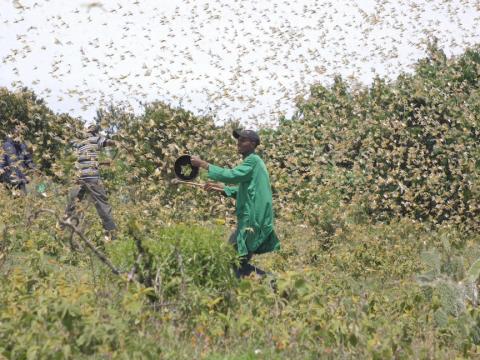COVID-19 Threat and Locust Invasion: Children and Families affected in Kenya

By Zipporah Karani and Charles Kariuki, World Vision Communications Officers, Kenya
Along a dusty road at Laisamis in Kenya, government officials are hard at work, spraying freshly hatched locust nymphs (hoppers) that have infested vast lands and devoured vegetation in the area.
As they flex their arms, moving the spraying hose in different directions, beads of sweat can be seen trickling down their faces.

The scorching heat from the sun feels unbearable. But the ground spraying team is taking it in stride, donned in dark blue overalls and transparent facemasks, which shield them from fumes of the chemical sprays.
They are prepared to do what it takes, to tackle the locusts and minimise their devastating impact on the community.
Adan, an agricultural officer in Laisamis notes that almost all villages in the area have been affected by the harmful insects.
“Most of the people here are pastoralists. So it’s painful for them to watch helplessly as these locusts clear vegetation that serve as pasture for their livestock,” he says.

Kevin, a father with three children in Laisamis is already feeling depressed about the situation.
“These locusts are attacking everything. They have eaten shrubs and all the grass here. And you know this is a dry area that can’t support crop farming. If we don’t have food for our livestock, how will I feed my family,” he laments.

Laisamis, situated in Kenya’s Marsabit County, is one of the areas that is worst hit by the on-going East African locust plague.
The condition is dire. A recent situation report released by the United Nations Food and Agriculture Organisation (FAO) - released on April 14, 2020 – indicates that the current situation in East Africa remains extremely alarming as more swarms form and mature in northern and central Kenya,

The report warns of possible widespread destruction of crops and pastures by locusts in the coming months, leading to food security challenges for households.
In addition, the locust invasion is also expected to reduce household incomes by impeding livestock and crop productivity.
The impact will be dire on families and children, as communities grapple with the locust invasion, as well as the on going COVID-19 pandemic, which is also expected to adversely affect livelihoods.
“Without intervention, a potential famine situation is expected in the coming months,” notes Maina Kingori, the Associate Director for Disaster Management at World Vision, Kenya.

World Vision plans to support the provision of essential life-saving emergency assistance to communities affected by the locust invasion in Kenya.
In addition, the organisation will procure and distribute seeds to replenish destroyed food crops and regenerate damaged pastures.
“We will also enhance the availability of short-term food supply for animals so as to minimise the displacement of farmers as they look for fodder,” said Maina.